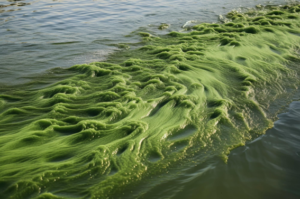Toxins produced by cyanobacteria
Cyanobacteria produce molecules, which are dangerous to humans and the environment.
Cyanotoxins are considered the most toxic natural compounds in water. They are secondary products of the metabolism of cyanobacteria, they exist both inside and outside cyanobacteria cells. When blooms occur cyanotoxins are present in harmful concentrations.

Algae Bloom in El Pañe reservoir, Peru. Source: Toxicrop project
Several species of cyanobacteria can produce strong toxins. Cyanotoxins have different chemical properties and cause different toxicological effects:
- Hepatotoxins: affect the liver, they are related to liver cancer and in extreme cases can cause death. Microcystin is the most common one.
- Neurotoxins: affect the nervous system and might lead to death due to heart and/or respiratory failure. The most common neurotoxins are anatoxin-a and saxitoxins.
- Dermatoxins: are not lethal but cause skin irritation upon contact. The most common ones are lyngbyatoxin and aplysiatoxin.

- The main routes of exposure are:
- Direct contact with exposed parts of the body (ears, eyes, mouth)
- consumption of contaminated water and food
In the environment, cyanobacteria and cyanotoxins will reduce biodiversity, they will affect the equilibrium in zooplankton species and the food chain can be altered.
Consumption of contaminated water is dangerous without proper treatment. It is important to measure cyanotoxins when monitoring bathing, irrigation, and drinking water.


